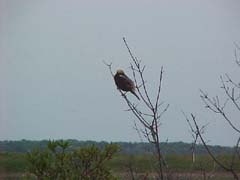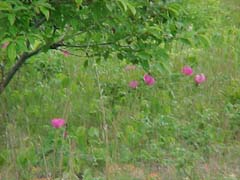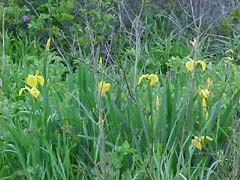|
Today's Bird Sightings:
Plum Island
eastern kingbird (2)
herring gull (4)
ringbilled gull (2)
double crested cormorant (7)
yellow warbler (2)
Bonaparte's gull (6)
common grackle (4)
northern rough winged swallow (1)
American robin (3)
least tern (2)
ruddy turnstone (1)
sanderling (54)
mallard (3)
seaside sparrow (1)
semipalmated sandpiper (12)
song sparrow (1)
redwinged blackbird (6)
snowy egret (2)
great egret (4)
Canada goose (23)
brown thrasher (1)
northern mockingbird (1)
bobolink (4)
Mammals:
red squirrel
Today's Reading: Summer: From
the Journal of Henry D. Thoreau edited by H.G.O.
Blake,
The Birds of Brewery Creek by Malcolm
MacDonald
Today's Starting Pitcher:
Pedro Martinez
Pedro's strikeouts: 10
2000
Book List
Plum
Island Bird List

Copyright © 2000, Janet I.
Egan
|
|
 There's
a lot less sand at the south end of the beach this morning.
A group of middle school kids is measuring the beach slope
with instruments they made in class. They've apparently been
out here every day this week. They're learning about beach
erosion. They picked a good place and a good week for that
particular subject. There's
a lot less sand at the south end of the beach this morning.
A group of middle school kids is measuring the beach slope
with instruments they made in class. They've apparently been
out here every day this week. They're learning about beach
erosion. They picked a good place and a good week for that
particular subject.
 I
don't know how the piping plovers fared with the northeast
storm the other day. I see one of the refuge biological
staff out surveying (on foot instead of in the ATV) but she
doesn't come down to the south end so I don't get a chance
to ask. I still haven't seen a piping plover this year. I
checked my notes and this is not the latest I have
gone without seeing one, although I've generally seen them
by mid-May. In 1996, I didn't see one until mid-June. Being
a plover warden doesn't guarantee that you'll see the little
invisi-birds. It just gives you a lot of opportunity to
explain the nesting habits and development of piping plovers
to anybody who'll listen. I
don't know how the piping plovers fared with the northeast
storm the other day. I see one of the refuge biological
staff out surveying (on foot instead of in the ATV) but she
doesn't come down to the south end so I don't get a chance
to ask. I still haven't seen a piping plover this year. I
checked my notes and this is not the latest I have
gone without seeing one, although I've generally seen them
by mid-May. In 1996, I didn't see one until mid-June. Being
a plover warden doesn't guarantee that you'll see the little
invisi-birds. It just gives you a lot of opportunity to
explain the nesting habits and development of piping plovers
to anybody who'll listen.
 One
entertaining sight I did see today was a front end loader
filled with lobster traps lumbering northward on the refuge
road. Then I got to see the same front end loader return
empty and drive onto the beach (accompanied by a refuge
employee) and start gathering more traps. Evidently the
storm was hard on lobster traps. The beach is littered with
them. One
entertaining sight I did see today was a front end loader
filled with lobster traps lumbering northward on the refuge
road. Then I got to see the same front end loader return
empty and drive onto the beach (accompanied by a refuge
employee) and start gathering more traps. Evidently the
storm was hard on lobster traps. The beach is littered with
them.
 It
was a pretty quiet birding day. That yellow warbler pair
that hung around with me for an entire shift before is still
around. They seem to have a nest somewhere in the brush on
the side of the bluff. I was watching the yellow warblers
flit in and out of the bushes and saw another flash of
yellow, which turned out not to be a rival warbler but some
yellow irises. I'd never noticed them before. But with them
and the yellow warblers being the only splashes of color in
an otherwise pretty dull landscape, they really stand out.
Actually, I think they're called Yellow Flag and are an
introduced European species escaped from gardens. Introduced
or not, they're pretty. It
was a pretty quiet birding day. That yellow warbler pair
that hung around with me for an entire shift before is still
around. They seem to have a nest somewhere in the brush on
the side of the bluff. I was watching the yellow warblers
flit in and out of the bushes and saw another flash of
yellow, which turned out not to be a rival warbler but some
yellow irises. I'd never noticed them before. But with them
and the yellow warblers being the only splashes of color in
an otherwise pretty dull landscape, they really stand out.
Actually, I think they're called Yellow Flag and are an
introduced European species escaped from gardens. Introduced
or not, they're pretty.
 A
Bonaparte's gull scrambles around at the water line with a
flock of sanderlings. With the naked eye it looks like a
larger shorebird but when I get it in focus, I'm surprised
to see a gull. It continues to act like a shorebird, dashing
in and out of the surf in synchrony with the sanderlings,
pecking at something in the sand. The sanderlings act like
it's quite normal to have a Bonaparte's gull in their flock.
They pay it no mind. It stays with them as the tide goes
out. A
Bonaparte's gull scrambles around at the water line with a
flock of sanderlings. With the naked eye it looks like a
larger shorebird but when I get it in focus, I'm surprised
to see a gull. It continues to act like a shorebird, dashing
in and out of the surf in synchrony with the sanderlings,
pecking at something in the sand. The sanderlings act like
it's quite normal to have a Bonaparte's gull in their flock.
They pay it no mind. It stays with them as the tide goes
out.
 Further
up in the wrack, two robins chase off a kingbird. The
aggrieved kingbird flies directly at the sanderling flock
scolding all the way 'til they all rise up and fly away -
one kingbird against 54 sanderlings. The gull left with
them. The kingbird flies back up to its spot on a pile of
wrack already abandoned by the robins. Further
up in the wrack, two robins chase off a kingbird. The
aggrieved kingbird flies directly at the sanderling flock
scolding all the way 'til they all rise up and fly away -
one kingbird against 54 sanderlings. The gull left with
them. The kingbird flies back up to its spot on a pile of
wrack already abandoned by the robins.
A visitor brings me a small eel in a Skittles bag with a
hermit crab. He asks for an identification. I don't have
Marine Life of the North Atlantic with me (it seems
to have migrated to the wrong bookshelf in my every
expanding library) and anyway this is a fingerling. Too
small and juvenile to identify without a lot of fishing
experience. The guy says he thinks it's a "wolf eel", which
I've never heard of. The woman with him says it has put her
in the mood for sushi. They let the "wolf eel" go and head
to their car for a drive to a Japanese restaurant. I'm
relieved I don't have to ask to see their fishing
license.
|
 There's
a lot less sand at the south end of the beach this morning.
A group of middle school kids is measuring the beach slope
with instruments they made in class. They've apparently been
out here every day this week. They're learning about beach
erosion. They picked a good place and a good week for that
particular subject.
There's
a lot less sand at the south end of the beach this morning.
A group of middle school kids is measuring the beach slope
with instruments they made in class. They've apparently been
out here every day this week. They're learning about beach
erosion. They picked a good place and a good week for that
particular subject. I
don't know how the piping plovers fared with the northeast
storm the other day. I see one of the refuge biological
staff out surveying (on foot instead of in the ATV) but she
doesn't come down to the south end so I don't get a chance
to ask. I still haven't seen a piping plover this year. I
checked my notes and this is not the latest I have
gone without seeing one, although I've generally seen them
by mid-May. In 1996, I didn't see one until mid-June. Being
a plover warden doesn't guarantee that you'll see the little
invisi-birds. It just gives you a lot of opportunity to
explain the nesting habits and development of piping plovers
to anybody who'll listen.
I
don't know how the piping plovers fared with the northeast
storm the other day. I see one of the refuge biological
staff out surveying (on foot instead of in the ATV) but she
doesn't come down to the south end so I don't get a chance
to ask. I still haven't seen a piping plover this year. I
checked my notes and this is not the latest I have
gone without seeing one, although I've generally seen them
by mid-May. In 1996, I didn't see one until mid-June. Being
a plover warden doesn't guarantee that you'll see the little
invisi-birds. It just gives you a lot of opportunity to
explain the nesting habits and development of piping plovers
to anybody who'll listen. One
entertaining sight I did see today was a front end loader
filled with lobster traps lumbering northward on the refuge
road. Then I got to see the same front end loader return
empty and drive onto the beach (accompanied by a refuge
employee) and start gathering more traps. Evidently the
storm was hard on lobster traps. The beach is littered with
them.
One
entertaining sight I did see today was a front end loader
filled with lobster traps lumbering northward on the refuge
road. Then I got to see the same front end loader return
empty and drive onto the beach (accompanied by a refuge
employee) and start gathering more traps. Evidently the
storm was hard on lobster traps. The beach is littered with
them. It
was a pretty quiet birding day. That yellow warbler pair
that hung around with me for an entire shift before is still
around. They seem to have a nest somewhere in the brush on
the side of the bluff. I was watching the yellow warblers
flit in and out of the bushes and saw another flash of
yellow, which turned out not to be a rival warbler but some
yellow irises. I'd never noticed them before. But with them
and the yellow warblers being the only splashes of color in
an otherwise pretty dull landscape, they really stand out.
Actually, I think they're called Yellow Flag and are an
introduced European species escaped from gardens. Introduced
or not, they're pretty.
It
was a pretty quiet birding day. That yellow warbler pair
that hung around with me for an entire shift before is still
around. They seem to have a nest somewhere in the brush on
the side of the bluff. I was watching the yellow warblers
flit in and out of the bushes and saw another flash of
yellow, which turned out not to be a rival warbler but some
yellow irises. I'd never noticed them before. But with them
and the yellow warblers being the only splashes of color in
an otherwise pretty dull landscape, they really stand out.
Actually, I think they're called Yellow Flag and are an
introduced European species escaped from gardens. Introduced
or not, they're pretty. A
Bonaparte's gull scrambles around at the water line with a
flock of sanderlings. With the naked eye it looks like a
larger shorebird but when I get it in focus, I'm surprised
to see a gull. It continues to act like a shorebird, dashing
in and out of the surf in synchrony with the sanderlings,
pecking at something in the sand. The sanderlings act like
it's quite normal to have a Bonaparte's gull in their flock.
They pay it no mind. It stays with them as the tide goes
out.
A
Bonaparte's gull scrambles around at the water line with a
flock of sanderlings. With the naked eye it looks like a
larger shorebird but when I get it in focus, I'm surprised
to see a gull. It continues to act like a shorebird, dashing
in and out of the surf in synchrony with the sanderlings,
pecking at something in the sand. The sanderlings act like
it's quite normal to have a Bonaparte's gull in their flock.
They pay it no mind. It stays with them as the tide goes
out. Further
up in the wrack, two robins chase off a kingbird. The
aggrieved kingbird flies directly at the sanderling flock
scolding all the way 'til they all rise up and fly away -
one kingbird against 54 sanderlings. The gull left with
them. The kingbird flies back up to its spot on a pile of
wrack already abandoned by the robins.
Further
up in the wrack, two robins chase off a kingbird. The
aggrieved kingbird flies directly at the sanderling flock
scolding all the way 'til they all rise up and fly away -
one kingbird against 54 sanderlings. The gull left with
them. The kingbird flies back up to its spot on a pile of
wrack already abandoned by the robins.